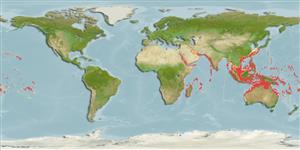Preferred temperature (Ref.
123201): 18.6 - 28.3, mean 25.1 °C (based on 608 cells).
Fylogenetische diversiteitsindex (Ref.
82804): PD
50 = 0.5000 [Uniqueness, from 0.5 = low to 2.0 = high].
Bayesian length-weight: a=0.00891 (0.00474 - 0.01676), b=3.11 (2.95 - 3.27), in cm total length, based on LWR estimates for this species & Genus-body shape (Ref.
93245).
Trofisch niveau (Ref.
69278): 3.5 ±0.37 se; based on food items.
Weerstandsvermogen (Ref.
120179): laag, minimale populatieverdubbelingstijd 4,5-14 jaar (Preliminary K or Fecundity.).
Prior r = 0.25, 95% CL = 0.17 - 0.38, Based on 1 data-limited stock assessment.
Fishing Vulnerability (Ref.
59153): Low to moderate vulnerability (29 of 100).
🛈
Climate Vulnerability (Ref.
125649): Moderate vulnerability (44 of 100).
🛈
Nutrients (Ref.
124155): Calcium = 40 [16, 81] mg/100g; Iron = 0.462 [0.219, 0.857] mg/100g; Protein = 18.1 [16.6, 19.6] %; Omega3 = 0.0809 [, ] g/100g; Selenium = 41.3 [21.5, 84.8] μg/100g; VitaminA = 63.4 [16.2, 259.7] μg/100g; Zinc = 0.993 [0.659, 1.434] mg/100g (wet weight);
